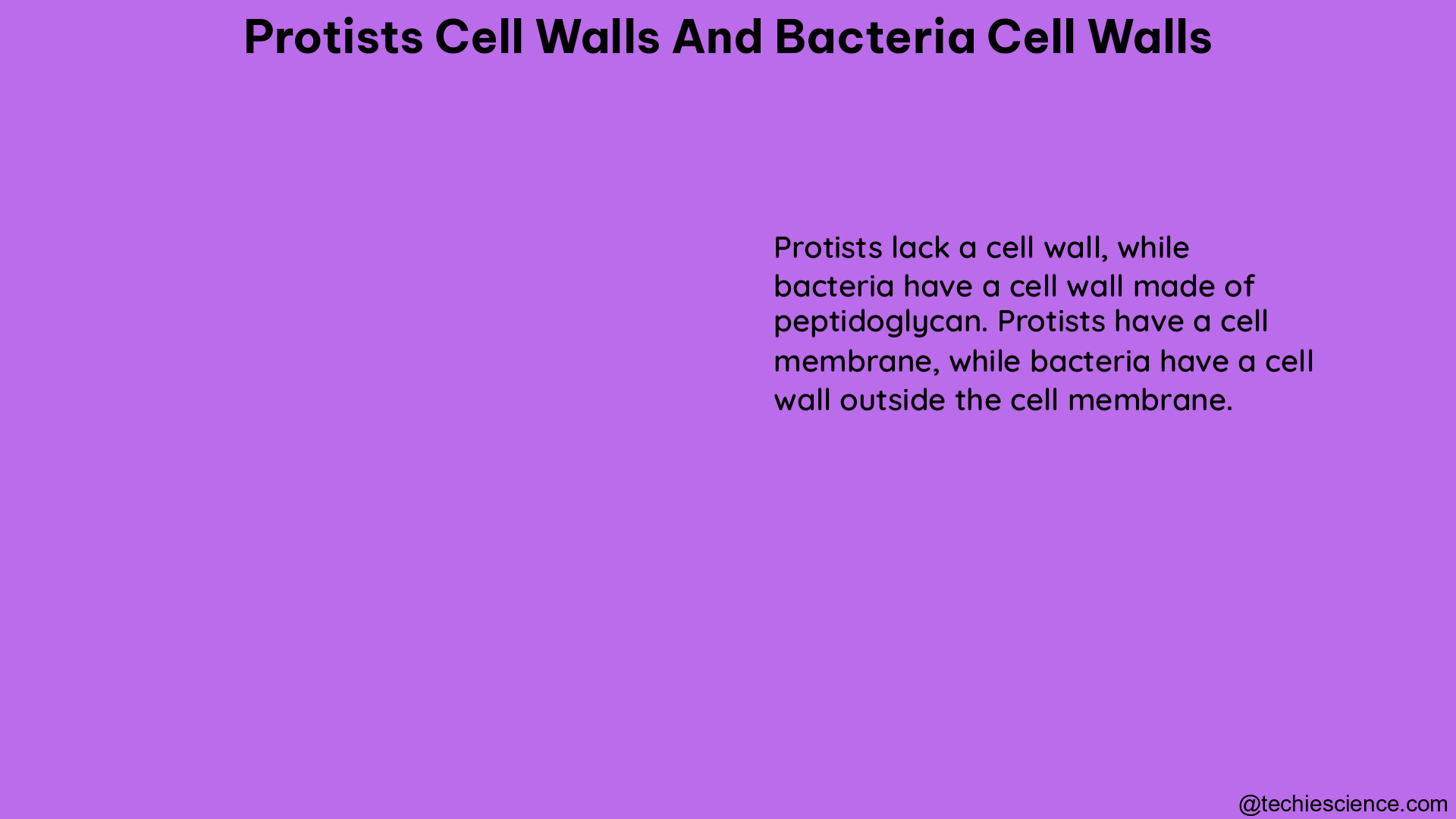Protists and bacteria have distinct cell wall structures and compositions, each with unique characteristics and functions. Understanding the intricate details of protist and bacterial cell walls is crucial for various fields, including microbiology, taxonomy, and biotechnology.
Protist Cell Walls: Diverse Structures and Compositions
Protists, a diverse group of eukaryotic organisms, can have a wide range of cell wall structures and compositions. While some protists lack a cell wall, others possess a cell wall that provides protection, support, and structural integrity.
Cellulose-Based Cell Walls
Plant-like protists, such as Caulerpa and Chlamydomonas, often have cell walls composed of cellulose, a polysaccharide found in the cell walls of plants. These cellulose-based cell walls can range in thickness from 50 to 200 nanometers (nm), depending on the species. The cellulose fibrils in the cell wall are typically arranged in a parallel or criss-cross pattern, providing strength and flexibility to the protist’s structure.
Non-Cellulose Cell Walls
Not all protists have cellulose-based cell walls. Some species, such as Euglenoids and Dinoflagellates, possess cell walls made of other polymers, including:
- Glycoproteins: These cell walls are composed of a combination of sugars and proteins, providing a unique structural and functional profile.
- Alginates: Certain marine protists, like some species of Phaeophyta (brown algae), have cell walls made of alginates, a family of polysaccharides.
- Silica: Diatoms, a type of unicellular protist, have intricate cell walls made of silica (silicon dioxide), which can be highly ornate and species-specific.
Unicellular and Colonial Protists
The cell wall structure of protists can also vary based on their growth patterns. Unicellular plant-like protists, such as Caulerpa, have cell walls that surround the entire cell and extend into the cytoplasm, forming structures called trabeculae. These trabeculae help maintain the organism’s leaf-, root-, and stem-like structures.
In contrast, colonial plant-like protists have a cell wall surrounding each individual cell, while a gelatinous ooze or extracellular matrix surrounds the entire colony. This arrangement allows the individual cells to function as a single unit, coordinating their activities and responding to environmental cues.
Bacterial Cell Walls: Peptidoglycan and Beyond

Bacteria, the prokaryotic counterparts of protists, have a distinct cell wall composition that sets them apart from their eukaryotic counterparts.
Peptidoglycan: The Backbone of Bacterial Cell Walls
The primary component of bacterial cell walls is peptidoglycan, a polymer composed of sugars (N-acetylglucosamine and N-acetylmuramic acid) and amino acids (primarily L-alanine, D-glutamic acid, D-alanine, and diaminopimelic acid). The thickness and structure of the peptidoglycan layer vary between different bacterial species.
- Gram-positive Bacteria: These bacteria have a thick peptidoglycan layer, typically ranging from 20 to 80 nm in thickness. The peptidoglycan layer in Gram-positive bacteria can account for up to 90% of the cell wall’s dry weight.
- Gram-negative Bacteria: In contrast, Gram-negative bacteria have a thinner peptidoglycan layer, usually between 2 to 7 nm thick, which makes up only 10-20% of the cell wall’s dry weight.
Additional Cell Wall Components
While peptidoglycan is the primary structural component of bacterial cell walls, some bacteria have additional layers or modifications that contribute to their unique characteristics:
- Teichoic Acids: Gram-positive bacteria often have teichoic acids, which are polymers of ribitol or glycerol phosphate, embedded in their peptidoglycan layer. These molecules play a role in cell signaling, ion regulation, and antibiotic resistance.
- Mycolic Acids: Certain bacteria, such as Mycobacterium tuberculosis (the causative agent of tuberculosis), have a cell wall composed of a thick layer of mycolic acids. These long-chain fatty acids provide additional protection and contribute to the bacteria’s resistance to certain antibiotics.
- Lipopolysaccharides: Gram-negative bacteria have an outer membrane composed of lipopolysaccharides, which consist of a lipid component (lipid A) and a polysaccharide component. This outer membrane acts as a barrier, protecting the bacteria from environmental stresses and immune system attacks.
Quantifying Cell Wall Characteristics
The thickness and composition of protist and bacterial cell walls can be analyzed using various analytical techniques, providing valuable data for comparative studies and taxonomic classification.
Analytical Techniques
- Transmission Electron Microscopy (TEM): TEM allows for the direct visualization and measurement of cell wall thickness, with a resolution down to the nanometer scale.
- Fourier-Transform Infrared Spectroscopy (FTIR): FTIR can be used to identify the chemical composition of cell walls, including the presence and relative abundance of different functional groups and biomolecules.
- X-ray Diffraction (XRD): XRD analysis can provide information about the crystalline structure and molecular organization of cell wall components, such as the arrangement of cellulose fibrils or peptidoglycan layers.
Quantitative Data
- Protist Cell Wall Thickness: The cell wall thickness of plant-like protists can range from 50 to 200 nm, depending on the species. For example, the cell wall of Chlamydomonas reinhardtii, a model green alga, is approximately 100 nm thick.
- Bacterial Cell Wall Thickness: The peptidoglycan layer in Gram-positive bacteria can range from 20 to 80 nm in thickness, while Gram-negative bacteria typically have a 2 to 7 nm thick peptidoglycan layer.
- Cell Wall Composition: The composition of protist and bacterial cell walls can be quantified in terms of the relative abundance of different sugars, amino acids, and other biomolecules. For instance, the peptidoglycan of Escherichia coli is composed of approximately 50% N-acetylglucosamine, 50% N-acetylmuramic acid, and various amino acids, including L-alanine, D-glutamic acid, D-alanine, and diaminopimelic acid.
By understanding the detailed characteristics of protist and bacterial cell walls, researchers can gain valuable insights into the evolution, taxonomy, and functional adaptations of these diverse microorganisms.
References
- Alberts, B., Johnson, A., Lewis, J., Raff, M., Roberts, K., & Walter, P. (2002). Molecular Biology of the Cell (4th ed.). Garland Science.
- Becker, B., Marin, B., & Melkonian, M. (1994). Structure, composition, and biogenesis of cell walls of green algae. International Review of Cytology, 151, 213-253.
- Beveridge, T. J. (1981). Ultrastructure, chemistry, and function of the bacterial wall. International Review of Cytology, 72, 229-317.
- Madigan, M. T., Martinko, J. M., Bender, K. S., Buckley, D. H., & Stahl, D. A. (2015). Brock Biology of Microorganisms (14th ed.). Pearson.
- Salton, M. R., & Kim, K. S. (1996). Structure. In S. Baron (Ed.), Medical Microbiology (4th ed.). University of Texas Medical Branch at Galveston.

Hi…I am Arti Pandey, have a Master’s degree in Biotechnology. I am an academic writer in Lambdageeks and also a beginner Korean learner. I love to explore new cultures, places, and food. I love photography and had a keen interest in creative writing.